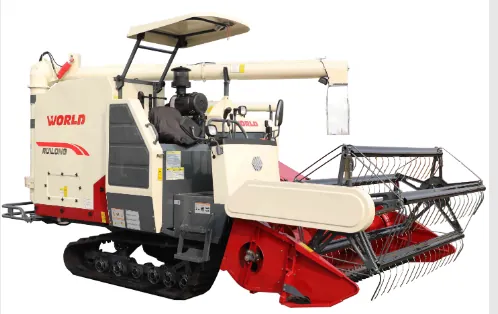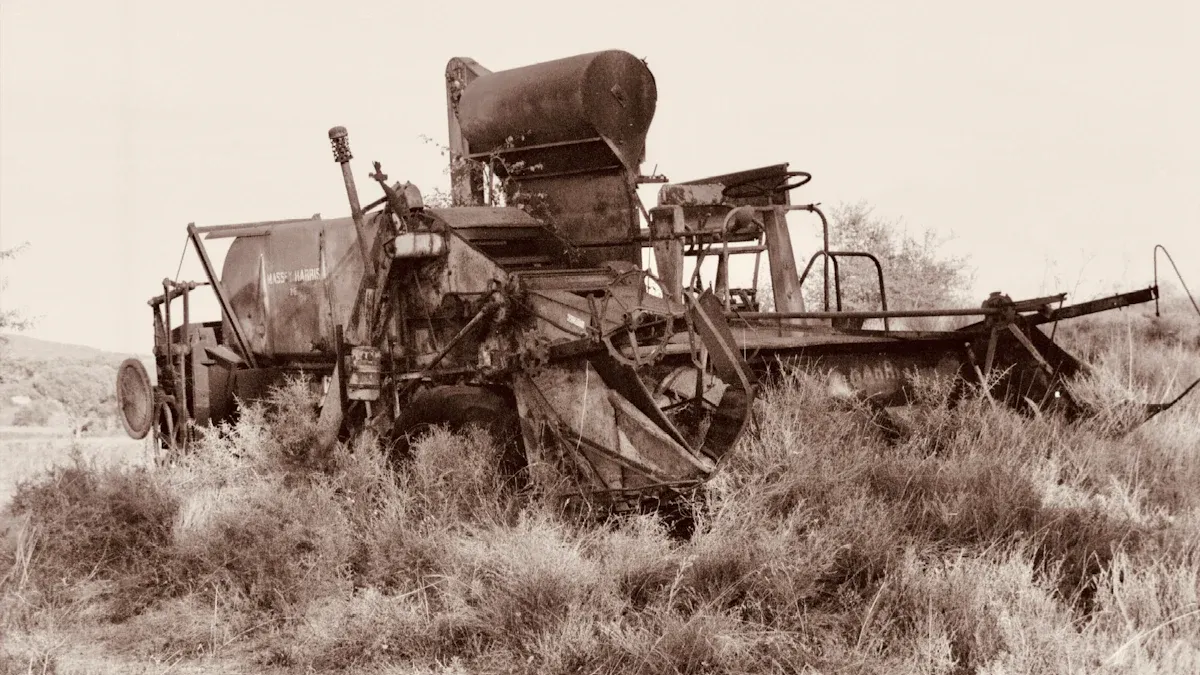Views: 0 Author: Site Editor Publish Time: 2025-08-18 Origin: Site
You might ask who is the inventor of the combine harvester. Hiram Moore, along with John Hascall, invented the combine and secured a patent for their machine in 1836. This important farm tool revolutionized the way crops are harvested by combining reaping, threshing, and winnowing into one process. The introduction of the combine harvester marked a significant change in farming practices.
The combine harvester makes farm work much faster.
You can harvest more land in less time.
Modern combines perform many tasks simultaneously, simplifying work and increasing your crop yield.
Hiram Moore and John Hascall made the combine harvester in 1836. This machine changed farming by joining reaping, threshing, and winnowing in one step. Using a combine harvester saves both time and hard work. It lets farmers harvest more land fast and easily. Modern combines have new technology like GPS and automation. These features help farmers work better and protect the environment. FMWORLD Agricultural Machinery has made combine harvesters even better. Now, they can do the job of up to 90 workers. They use smart controls and strong designs. Learning about the combine harvester's history helps you see how new ideas keep changing farming today.

You might wonder who the true inventor of the combine is. Hiram Moore and John Hascall stand out as the pioneers who changed farming forever. These two inventors worked together in the early 1800s. You can see their impact in every modern combine harvester today. Moore and Hascall wanted to help farmers harvest grain faster and with less effort. They built a machine that could do the work of many people at once.
The inventor of the combine did not just create a new tool. Moore and Hascall started a movement that shaped the future of agriculture. Their invention made it possible for you to harvest large fields quickly and efficiently.
You can picture the excitement in 1834 near Climax, Michigan, when Moore and Hascall put their first combine harvester to practical use. Farmers saw a machine that could reap, thresh, and winnow grain all at once. This was a huge leap forward. Before this, you had to use separate tools for each step. The inventor of the combine made it possible to do everything in one pass.
You may ask, "When was the first combine made?" The answer is June 28, 1836. On this day, Moore and Hascall received the patent for their first combine harvester. This patent marked a turning point in farming history. You can find the details of their invention in the patent records:
The first combine harvester was patented by Hiram Moore and John Hascall on June 28, 1836.
The machine was first used in 1834 near Climax, Michigan.
Their invention combined reaping, threshing, and winnowing into one process.
You might also wonder, "When was the first harvester made?" The answer is the early 1830s, when Moore and Hascall began building and testing their machine. The inventor of the combine wanted to solve a big problem for farmers. You needed a way to harvest grain faster and with less labor. Their solution changed everything.
The first combine was not just a machine. It was a symbol of progress. You can see how the inventor of the combine helped farmers save time and increase their harvest. Today, every combine harvester builds on the ideas Moore and Hascall started. Their work shows you how one invention can change the world.

The story of the combine harvester starts with old reaping machines. Long ago, farmers used hand tools like sickles and scythes to harvest wheat. These tools took a lot of time and hard work. Inventors wanted to make harvesting faster and easier. In the late 1700s and early 1800s, mechanical reapers were invented. These machines had blades and gears that cut crops quicker than hand tools. These early machines helped lead to the combine harvester.
Cyrus McCormick made farming better with his mechanical reaper. His invention helped farmers harvest wheat more quickly. Farmers in the Midwest started using the reaper right away. This changed how people farmed and helped the farm economy grow. McCormick used smart ways to sell his machine all over the country. The mechanical reaper became an important part of combine harvester history.
You can see how McCormick’s reaper had special features. These features helped make later combine harvesters better.
Feature | Description |
|---|---|
Gearing | Moves power to the right parts |
Divider | Splits the crop from what is not cut |
Reel | Pushes the crop into the cutting part |
Straight reciprocating knife | Cuts the stalks well |
Finger | Moves the crop to the knife |
Platform | Holds the cut stalks for collection |
Main wheel | Helps the machine move |
Draft traction | Makes it easier to pull the reaper |
These parts became important for new combine harvesters.
Before engines, animals pulled combine harvesters in fields. Horses or mules helped move these early machines. These combines could reap, thresh, and winnow grain all at once. Animal-powered combines made harvesting wheat much faster than using only hands. Farmers could work on more land and get bigger harvests. The history of the combine harvester shows how each new idea made things better. Inventors kept improving machines over time.
You can see how the history of the combine harvester links old reaping machines, McCormick’s reaper, and animal-powered combines. Each invention helped make the combine harvesters we use today.
You can follow the story of the combine harvester by looking at many inventions. Early machines had gears and blades that were simple. New ideas kept changing how farmers did their work. In the 1800s, inventors made steam-powered combines. These machines helped farmers harvest crops faster. Later, in the early 1900s, gasoline engines were added. This let you use bigger and stronger harvesters. By the middle of the 1900s, the self propelled combine arrived. It could cut, thresh, and separate grain all at once. Today’s combines use GPS, yield mapping, and auto steering. These tools help you farm more accurately and save time.
Every new step in combine harvester history made farming easier. Technology helped you harvest more land with less work.
Here are some inventors who helped make combine harvesters better:
Inventor | Contribution |
|---|---|
Thomas Carroll | Made the first successful self propelled combine, called Massey-Harris 21SP. |
Raymond Hanson | Created the first self-leveling controls for hillside combines. This saved grain during harvest. |
You get help from these inventions when you use a self propelled combine. The story of these machines shows inventors wanted to fix problems and make farming better.
There was a big change when engines replaced animals in combine harvesters. Early combines needed horses or mules to pull them. When engines were used, you could harvest faster and cover more land. The self propelled combine became popular because it did many jobs at once. You save time and do less hard work with these machines. Engine power also helps you get more grain and lose less crop. This change means you can grow more food for people everywhere.
Today, you use self propelled combine harvesters to make your work easier and get more done. The story of engine power in farming shows technology keeps making harvests better.
Innovation changes farming every time you use a modern combine harvester. FMWORLD Agricultural Machinery started improving harvesters in the mid-1990s. At first, our machines did the work of 15 to 20 people. By 2007, they matched the work of 30 to 45 workers. In 2017, our machines could do the job of up to 90 laborers. This helped farms everywhere get more done.
We now have branches in Thailand, India, and Vietnam. Farmers in more than 58 countries use our tractors and harvesters. We make our products with advanced technology and careful engineering. You can see all our machines at FMWORLD Harvesting Series.
FMWORLD gives you strong machines, great performance, and a team that helps you succeed in wheat farming.
Feature | Description |
|---|---|
Performance | Great performance and strong quality |
Technology | Smart technology for better harvesting |
Engineering | Careful engineering for good crop harvesting |
Construction | Tough build for hard farm work |
Engine | 102HP diesel engine for strong work |
Material Tech | Steel and aluminum body for long life |
Modern combine harvesters have special features that help you a lot. These machines cut wide paths, over 40 feet across. Their grain tanks hold up to 485 bushels. You can unload grain fast, at 6 bushels each second. Remote controls let you check how your machine works from anywhere. Self-propelled models use less fuel and work better than old tractor-pulled ones.
Modern combine harvesters do many jobs at once, so you get more crops and lose less.
You need fewer workers and can do your job better.
New technology uses less fuel and makes less pollution, which is good for the earth.
Track-type models keep the soil safe by pressing it down less.
Eco-friendly designs follow world rules for clean farming, so you help the planet.
You notice the difference in your harvest. Machines cut harvest time by 58% and let you work on 20 acres each hour. Automation, like speed control and smart settings, makes your job easier and helps your crops grow better. As more places use machines, you join others around the world who want farming to be fast and good for the earth.
You can think of the history of the combine harvester as a story about progress. This machine made farming much faster and easier for everyone. The inventors left behind ideas that still help you today. Every time you use new technology, you follow their path. Modern machines keep improving with things like:
Automation helps you do less hard work.
GPS helps you harvest crops better.
Advanced sensors check your crops right away.
Companies such as FMWORLD help make farming better for the planet. Their part in history is important:
Aspect | Description |
|---|---|
Eco-friendly Manufacturing | FMWORLD uses ways that keep the earth safe. |
Sustainable Product Design | Their combines are made to help farms last a long time. |
Promoting Sustainable Farming | They teach you how to use smart farming and save soil for the future. |
You join this story when you pick new ideas. The history of the combine harvester grows as you and FMWORLD help farming change for the future.
A combine harvester cuts, threshes, and cleans grain crops all at once. This saves you time and makes your work easier. Farmers use combines for wheat, rice, corn, and other grains.
Tip: Using a combine harvester helps you get more crops and spend less money on workers.
Hiram Moore and John Hascall made the first combine harvester. They got a patent in 1836. Their machine changed farming by doing three jobs with one tool.
Inventor | Year | Contribution |
|---|---|---|
Hiram Moore | 1836 | First combine harvester |
John Hascall | 1836 | Patent co-holder |
FMWORLD Agricultural Machinery uses new technology and strong design. Their machines have smart controls and tough parts. You can harvest more land with less hard work.
Smart controls
Tough build
High productivity
You can use a combine to harvest wheat, rice, corn, soybeans, barley, and oats. FMWORLD machines work well for many kinds of grains.
Note: Check your combine’s settings to get the best results for each crop.
You can call FMWORLD’s help center any time for support. You get expert advice, spare parts, and training. FMWORLD helps you from setup to keeping your machine working.
24/7 call center
Expert technical team
Fast spare parts supply
Ready to make your harvest better? Get a quote from FMWORLD today!
Email:fmworld.agro@worldgroup.com.cn
WhatsApp:+86-15906103178
Phone:+86-0511-86349102